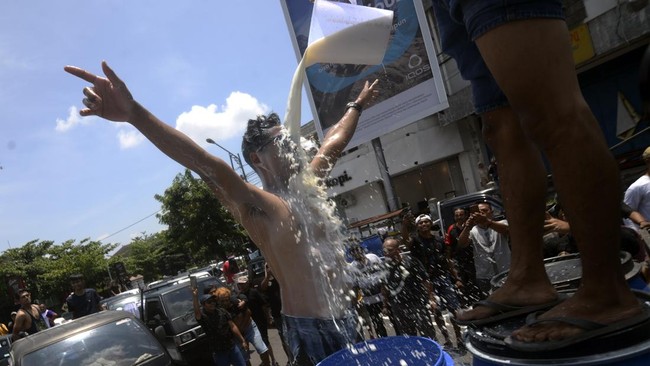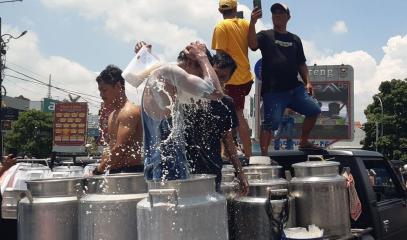Milk protest in Java: tonnes of litres dumped in the streets
In Boyolali last week, dozens of farmers used it to ‘take a bath’. Behind the discontent is the unresolved issue of quotas. Today at least 80% of the raw material comes from abroad. For years there has been a demand for a law to regulate the sector.
Jakarta (AsiaNews) - In the Boyolali region of Central Java, a protest by Indonesian milk producers against the massive importation of the raw material has exploded, and the contours it has taken over the past few days have caused deep dismay among citizens and civil society. Last week, in fact, dozens of dairy farmers gathered to demonstrate threw away thousands of litres of fresh milk, using them for a group ‘bath’.
Last week's demonstration in the streets was linked to farmers' frustration over the treatment received by local fresh milk compared to that imported from abroad. This discontent is the result of government policies that have led to almost 200,000 tonnes of product being thrown away.
The wrath and discontent of the farmers did not only affect the Boyolali region, but involved other towns on the island of Java. In the previous days, similar scenes with huge quantities of milk dumped on the streets were seen in Pasuruan, in the east, also because after 40 hours in the temporary warehouses, the product was now unusable.
‘This can only happen when local fresh milk products are not purchased by the so-called Milk Production Industry, or Ips,’ explained Teguh, a member of the National Milk Council in a note dated 9 November. The Centre of Reform on Economics (Core) Indonesia points the finger at the lack of cooperation between dairy farmers and regulatory agencies. ‘The facts show that no more than 20 per cent of the total Indonesian dairy farmers have signed a partnership with the agencies,’ says Eliza, a Core representative. And with domestic production barely reaching 21%, ‘at least 79% is bought,’ she warns, ‘from abroad’.
Cooperatives Minister Budi Arie Setiadi confirms that 80 per cent of the milk supply to meet domestic demand is imported. Government estimates show national milk consumption in 2022 and 2023 at 4.4 and 4.6 million tonnes respectively. Meanwhile, according to existing trade data, national milk consumption in 2022 and 2023 was 4.44 million tonnes and 3.7 million tonnes, respectively.
Currently, the number of national dairy cooperatives reaches 59. In 2023, the number of cows in dairy cooperatives was 227,615, which produced a total value of 470 thousand tonnes of milk. In contrast, modern dairy farms with 32 thousand cows can produce 164 thousand tonnes. Currently, the country from which the largest amount comes is New Zealand, which produces 21.3 million tonnes of milk. Together with Australia, Wellington benefits from the free trade agreement (FTA) with Jakarta.
At the moment, a 2018 law that is supposed to regulate the dairy sector under a farmer-agency partnership is still under discussion. In response to the new protests, Indonesia's Minister of Agriculture Amran Sulaiman suggested suspending the import permit to five Ips entities. ‘The amendment is still under discussion, so that the industry,’ the minister explains, ‘can buy fresh local dairy products. In 1997-1998, the International Monetary Fund (IMF) had forced Jakarta to revoke the binding regulation for the absorption of local fresh milk products by the Ips, due to the growing need in the domestic market.
07/02/2019 17:28
12/02/2016 15:14









.png)










